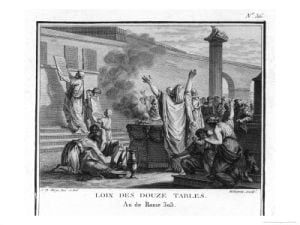More content
Law of the twelve tables (Lex Duodecim Tabularum) was the first codification of Roman law made in 451-449 BC. It was undoubtedly the plebeian’s greatest victory over the aristocracy. The beginnings of the creation of Law XII. Tablets should be seen in the early republic. Rome ruled by patricians was characterized by social injustice. The rich WERE represented by the Senate, could not fear that they would lose their rights. This situation was uncomfortable for the pleb because it had no representation on the legislative forum. One of the plebes’ demands was to write down customary law. His knowledge and interpretation were reserved for pontificis derived from patricians, which strengthened their power. The victory of plebeians over patricians who supposedly wandered from Rome to the Holy Mountain in 494 BCE, enabled them to establish the so-called people’s tribune (tribunus plebis). These officials were to represent the plebeian community before the Patrician state. Changes in the state continued.
Success in the fight against the aristocracy encouraged the people to make further demands. As a result, the law was written down, including criminal law, which was particularly inconvenient for plebe. The creation of the written law was undertaken by a special commission of 10 patricians (Decemviri legibus scribundis – hence called decemvirs) in 451 BCE. The codification lasted from 451 to 449 BCE The slowness of the commission caused the so-called. 2nd plebeian secession. For fear of a civil war, the patricians agreed to set up a second commission to which two plebeians were admitted. The commissions went to Greece to draw on the elements in force in Greek cities to the law being created and in 449 BCE the written law was solemnly proclaimed by the consuls. This document contained customary laws that significantly limited the patricians’ strength and activities. These rights were published on twelve bronze tablets (leges duodecim tabularum) and posted on public view at the Roman Forum so that it could be known to all citizens. The law included private law, certain provisions of criminal law and religious law. The law of the XII Tablets did not abolish the division between patricians and plebeians, however, it eliminated the freedom in interpreting the law by patricians. To this day, it serves as a model for creating a constitution in democratic states. If the Greeks were seen as the unmatched creators of culture, then the inhabitants of the Tiber were admired for their achievements in the field of lawmaking and development.
Writing down customary law resulted in further transformation of the republic. Further offices were established and the powers of the People’s Assembly were increased, which clearly strengthened the state structures.
The original boards disappeared quite quickly, and the original content of the law has not survived to this day – we know them only from reconstructions based on Roman legal literature and grammar (grammarians cited fragments of the act to illustrate old forms words). The meaning of the “law of the twelfth tables” was not limited to the political victory of the plebeians. It introduced a court procedure (legislative process) – “Salarium incertae pollicitationis peti non potest”.
It initiated the dynamic development of Roman law. Initially, until the time of Gnaeus Flavius, his interpretation was dealt with by the College of pontificis. The law of tables XII was one of the basic sources of Roman law. Titus Livius (3, 34) referred to her as fons omnis publici privatimque iuris (source of all public law and private). Despite the fact that some provisions went out of use over time, the bill itself was never repealed. Justinian treated it as still in force, the division of the Code into 12 books referred to 12 tables.
In the royal period, the law was divided into ius (secular law) and fas (divine law). The Act of XII tables indicates the victory of the former.
According to known reconstructions, Act XII of tables had the following order:
- Tables I, II, III – procedural law (e.g. Si in ius vocat est ito – if you have been called to court, then get involved; favouring wealthy citizens – the keeper of the holder could only be another holder; institution nexum – strict personal liability of the debtor).
- Tables IV and part V – internal organization of a Roman family (e.g. a father cannot sell his son more than three times).
- Part of table V – inheritance (e.g. testaments of inheritance).
- Table VI – economic relations between Roman families (e.g. obligation to make declarations made solemnly during the act of mancipation).
- Table VII – neighbourhood rights (e.g. no change in rainwater to the detriment of a neighbour).
- Table VIII – crimes violating the rights of a Roman citizen (e.g. the right of a talion in the event of permanent mutilation with the option of buying out in the event of a settlement, a penalty of 300 aces for lighter mutilation of the free and 150 for a slave payable to hands) its owner, 25 aces for insulting a free citizen).
- Tables IX and X – religious and public laws (e.g. prohibition of burial and burning of corpses in Rome, limitation of the funeral expense).
- Tables XI and XII – various provisions (including the ban on marriage between patricians and plebeians).







